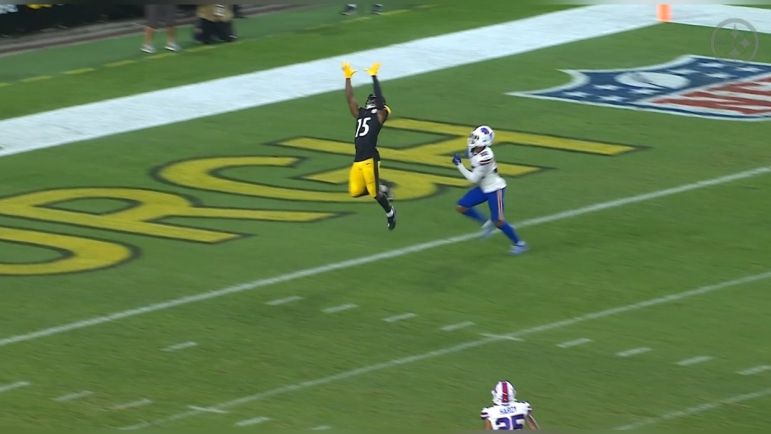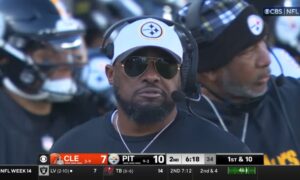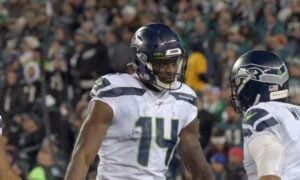Pittsburgh’s offense could only muster a field goal in Saturday night’s preseason loss to the Buffalo Bills, a 9-3 loss and the team’s lowest combined scoring preseason contest since a 10-0 loss to the Carolina Panthers in 2014. But the Steelers had two chances to add to their point total. Chris Boswell missed a 52-yard field goal, clanking off the upright. But the bigger miss was Justin Fields’ deep ball incompletion to WR T.J. Luther late in the fourth quarter on what should’ve been a 40-yard touchdown.
Luther was open, beating the corner, with no safety help over the top. But the ball never even hit Luther’s hands and fell incomplete in the end zone. How does something that’s about to go so right end up so wrong? Let’s try to figure it out.
First, a look at the play from the All-22 aerial view. Out of 12 personnel with reduced splits, classics of an Arthur Smith-led offense, the Steelers run a Yankee concept. Luther, to the top, runs the post while WR Quez Watkins to the bottom runs the over/crosser. Either the safety will cut the crosser and leave the CB out-leveraged over the top on the post or the crosser will find grass across the field.
In this case, the safety cuts Watkins, leaving Luther one-on-one against the LCB to the top. Fields makes the right read and fires downfield. Luther has leverage and a step and this should be a score.
But it wasn’t. The pass falls over Luther’s head, leaping and not able to track the ball well, and lands incomplete. A big missed chance.
How did it get screwed up? Admittedly, it’s tough to accurately judge miscommunication and it’s obvious receiver and quarterback aren’t completely on the same page here. Luther breaks his route more sharply than where Fields is throwing it. Without correct examples to compare and contrast, there’s more guesswork in assigning blame.
My first thought was watching Luther slow down and jump too early. And that still feels valid. Luther doesn’t adjust to it well, Fields throw it right as Luther is about to make the break on his route, and Luther felt a little late in being able to find and judge the flight of Fields’ throw. Former NFL players Cris Carter and QB Kurt Benkert, who I acknowledge had very different professional careers, attributed Luther’s poor route as the main culprit.
No question that the end of Luther’s route isn’t pretty and certainly not the way it’s coached. However, I’m not willing to put the blame all on him either. Often, the aiming point on this type of skinnier post is for the receiver to break to and the quarterback to throw for the near upright. Fields’ throw misses that mark to the right. If it’s thrown on the near upright, Luther is going to make the catch for the score.
While the points above contend a high-talent receiver makes that catch, and that’s certainly possible, these throws that are too far outside will cause even elite receivers to slow and have trouble judging the football. Here’s Joe Burrow missing in a similar fashion to Ja’Marr Chase at LSU.
And here they are connecting on it for a touchdown, the ball a little more in front to allow his receiver to run under it, which is what I would’ve liked to see from Fields here. There’s no safety to worry about. It’s 1v1 with an outside leverage corner. Don’t throw on such a harsh angle. Throw away from the corner into open grass and let the receiver keep his speed to run to the ball. Only a small adjustment would’ve worked.
But my conclusion reflects Dave’s point. Context is key. T.J. Luther is not Justin Jefferson or George Pickens. As of Saturday, he’d been with Pittsburgh for three days, had very few reps, zero catches during training camp, and that might’ve been the first pass Justin Fields has ever thrown him. Fields was working with the 1’s and 2’s, Luther with the 3’s and 4’s. There isn’t much overlap here.
When you have a new guy and not exactly the next All-Pro receiver, there’s often miscommunication on the details. Where does the receiver break, how fast is he, what’s his catch radius, where is the quarterback going to put the ball, etc. That lack of timing is what throws off the play and leads to the incompletion.
As unsatisfying as the answer is, that’s my takeaway. Just the pitfalls of a quarterback and receiver not being on the same page. Make me choose and I’ll put more on Fields than Luther here but like any big-play, it usually requires some practice. Something I bet these two didn’t have prior to this play-call.








